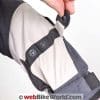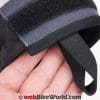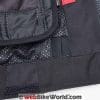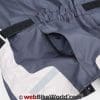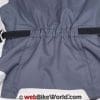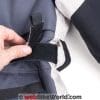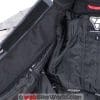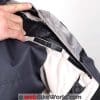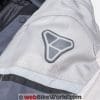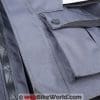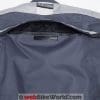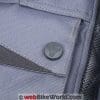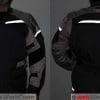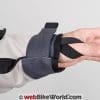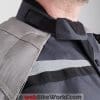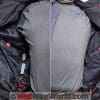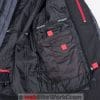The original version of the Pilot Trans Urban jacket we reviewed in 2013 was a wBW Product of the Year award winner. Version 2 has now arrived and like the original, it brings a lot of value for a reasonable price of just $15.00 more. That list price of $240.00 gets you a shell made from high-quality materials offering not only good protection from abrasion, but waterproofing as well.
The Trans Urban Jacket V2 follows the design philosophy of the original in that it uses a permanent waterproof mid-layer and a removable thermal liner. Other similarities include CE rated protection in the shoulders and elbows and the Pilot “Red Tab” system to make it easier to find the attachment points for the liner.
All of this adds up to to the same winning formula that made us fans of the original Trans Urban jacket.
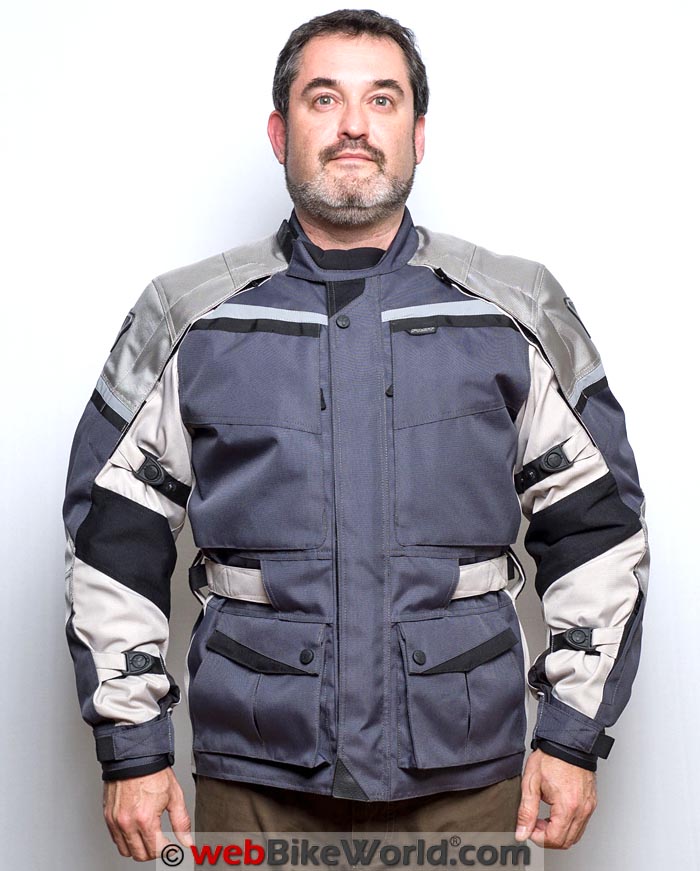
Background
Just to recap, Pilot Motosport has been making custom leather suits for AMA motorcycle racers and others for many years. Pilot is also an Original Equipment (OE) manufacturer of the branded apparel for Honda, Kawasaki, Suzuki, Yamaha and many others.
Several years ago, Pilot started making their own line of motorcycle gear for retail. The original Pilot Trans Urban jacket was introduced at the 2013 AIMExpo show (report) and was described to webBikeWorld readers in the Pilot Trans-Urban Jacket preview, reported live from the show.
We followed that up with a full review in 2013 and the Trans Urban jacket went on to win a webBikeWorld Product of the Year Award that year. It’s also proven to be very popular with many motorcyclists, so it was only natural for Pilot to release a “V2”, or Version 2.
Introduction
The 3/4-length textile jacket has become a mainstay of motorcycle riders everywhere. Adventure-touring versions in particular have flooded the market recently, and with good reason. The longer coverage is not only great for adventure types who may occasionally stand up on their foot pegs when off road, but it also provides more coverage for commuters and touring riders from bad weather.
But the pockets and other “in-jacket” storage found on these types of jackets may also appeal to riders of sport bikes and even cruisers, which typically don’t have much provision for on-board storage. “Versatile” is perhaps the best way to describe the 3/4-length adventure-touring jacket in one word. They can do a lot of things very well even though they may not be the best at everything.
Many motorcycle riding apparel manufacturers have added at least one jacket in this category, if not several, and with the market full of choices, it has become difficult for any one specific jacket to stand out. With that said, I think the Pilot Motosports Trans Urban Jacket V2 may get the nod.
It doesn’t necessarily do this with unique features, styling or price, but by serving up an excellent mix of the three to create a jacket that is more than the sum of its parts.
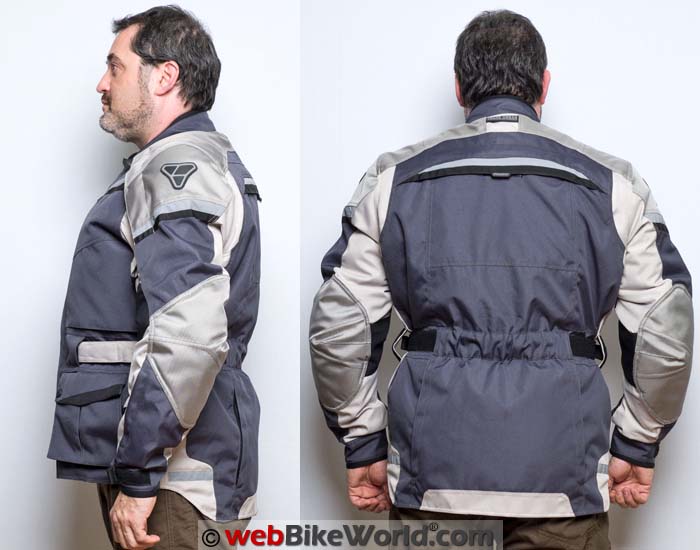
The Pilot Trans Urban Jacket V2
My Trans Urban Jacket V2 is in the grey/dark grey color scheme. It could really be called “Multi Shades of Grey”, as has areas of black, dark grey, medium grey, light grey and even some grey reflective strips included. The result is a very smart-looking piece of kit, although this color scheme it might be a bit subdued for those who prefer Hi-Viz apparel. Not to fear, however, as the Trans Urban is also available in yellow, along with an all black and a silver/black version.
The branding on the Trans Urban V2 is subtle. Besides the triangular logo patch on the shoulders and the small “PILOT” tag on the front left chest pocket and on the upper back, you’d be hard-pressed to figure out the manufacturer.
Like the previous Trans Urban jacket, the new V2 feels durable and comfortable, something not always easy to find in one piece of apparel.
Pilot has taken an already excellent jacket and updated it without spoiling the good genes that are already present, adding just $15.00 to the list price of the original.
Trans-Urban Jacket Shell Construction
If you’ve read our review of the original Trans Urban jacket, a lot of this next part will sound familiar. The outer shell is made from what Pilot refers to as “Pilotex NPF”, which is a relatively thick weave of poly/nylon fabric. Most of the outer shell is made with a 600 denier weight, with the impact areas getting an additional overlay of a 1680 denier material for additional abrasion resistance.
On the inside of the elbows is a special 1000D stretch “FlexDura” fabric, which does have a bit of stretch, but not too much. Overall, the materials look like they would make for a stiff jacket shell but it actually moves more easily and more quietly than I expected. Also, the jacket’s weight is a lighter than expected and it has an overall bulky look, which sort of makes it seem even lighter when you first put it on.
The arms are pre-curved so they are optimized for the riding position. The sleeve cuffs have a generous amount of hook-and-loop fastener to allow for a wide range of wrist sizes and also to allow for glove cuffs to be located either on the outside or inside of the sleeve opening.
The multi grey version has the widest variety of color shades. The main front and rear sections use a dark charcoal grey color with just a hint of blue. The inside facing sides of the sleeves are light grey, which is also used on the front adjustment straps. The elbows and shoulders are the 1680D material that has a mid-grey color and it also connects across the upper back.
Reflective 3M Scotchlite is used in two strips at the upper chest, one across the top of the back, and a strip on the outside of each arm just under the deltoids.
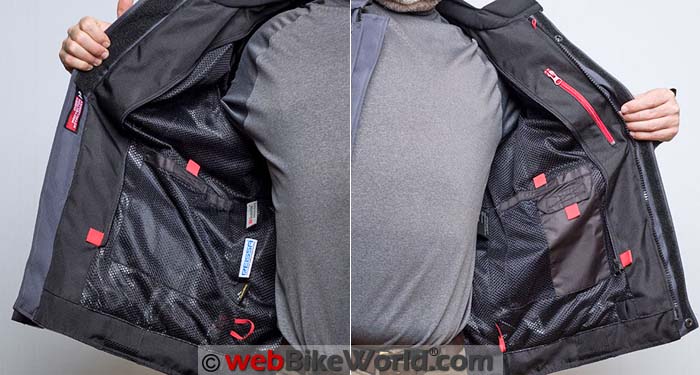
Zippers & Waterproof Liner
The main closure for the jacket uses a large coil dual YKK zipper allowing the ability to unzip from the bottom, which is a useful and a pretty much necessary feature for a long jacket like this. In addition to the zippers, there is a solid full length strip of hook-and-loop to provide a good seal with an overlapping storm flap.
Finally, a large snap is located at the bottom and near the top of the main opening. The top snap is about 2.5 inches (6.3 cm) from the top of the zipper run to provide s nice “stop” to open the collar a bit at the top on warmer days.
The overall construction of the jacket is very solid and the stitching is very good and even. I discovered no loose threads or pulls while inspecting the shell.
The Trans Urban V2 uses a permanently attached REISSA waterproof mid-liner underneath the main shell to provide protection from the wet. The outer shell seems pretty resistant to water also and Rick demonstrated this in our review of the previous version, but of course I wanted to test this for myself.
Duplicating the technique used before, I created a bowl shaped space with the shell and then added water. I let it sit for an hour and no water appeared to make it through the outer layer. Keep in mind that a static test like this doesn’t tell the whole story, because a raindrop hitting the shell at 60 mph might still find its way through. But that’s where the REISSA liner comes into play. As part of the mid-liner setup, there are three drain holes that can be seen at the bottom edge of the jacket liner, which allow water to escape if it gets past the shell and to the REISSA liner.
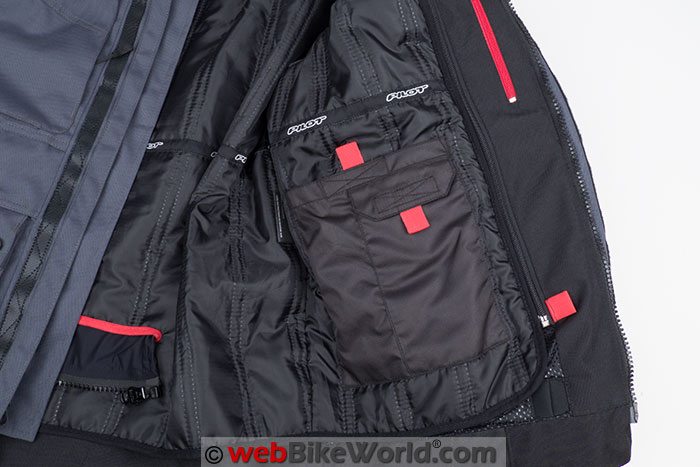
Jacket Features
The designers at Pilot spent time working closely with riders to develop this jacket. Several of these features are carry-overs from the previous version but they bear repeating.
RedTab System
For example, the “RedTab” system is a convenience feature that makes it easy to find openings and connection points inside the jacket. Straps and pulls for attaching the thermal liner are colored in bright red making them easy to find in the dark sleeve interior or any time when you might need to change the liner in the dark.
The openings for each interior pocket have a large red tab indicating where to pull to open the hook-and-loop fastener closures. There are also tabs on the beginning and end of the interior zipper for the zip in liner. Additionally, the hang tab is colored in the same red as is the entire zipper for the interior Napoleon style pocket. There is even a small red loop near the main closure for guiding a headphone wire.
This red call out system is also duplicated on the thermal liner itself making it easy to spot all the interior pockets as well as the pass through port for the pants connection zipper.
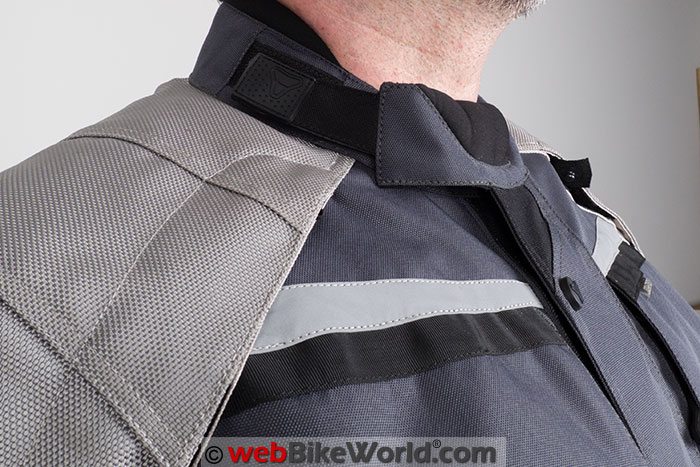
Snaps and Buttons
All of the snaps on the outside of the jacket are covered with a soft coating to prevent scratching of paint on the bike. Along that same line, Pilot has removed the exposed button at the bottom of the main opening that was on the previous version further reducing the chance of it rubbing on the tank. Zipper pulls for the two chest pockets are positioned to easily grab with gloved hands.
And speaking of hands, those widely adjustable sleeve cuffs have large pull tabs and they terminate on top of the wrists like on the previous version of the Trans Urban jacket.
Sleeve Pockets
We’ll get into pockets in a little later but there is one I want to call out at this point and that is the pocket on the left forearm. This “at hand” pocket is a great spot for placing small items like keys or ID/credit cards, or coins.
Why there isn’t one on the right arm as well I’m not sure but I’ll take what I can get.
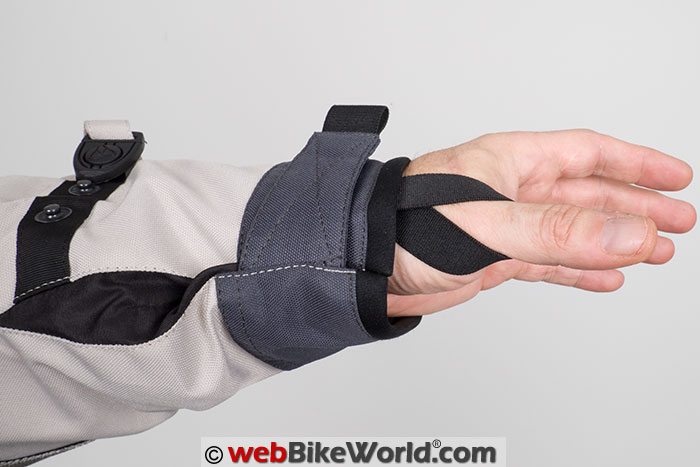
Thumb Loops
Something that I don’t care for but many find useful are thumb loops in the ends of the sleeves. These small fabric loops slip around your thumb and help keep the sleeve in place as one pulls glove gauntlets over the sleeve cuffs.
I didn’t find the material very comfortable and it is a bit scratchy over time. They are easy enough to tuck inside the sleeve or simply cut out if you don’t plan on using them.
Cable Port
A pair of rubberized fabric ports (neoprene?) allow passing through of a cable for a heat controller from inside the shell into the far corner inside the lower left hand warmer pocket. In the review from 2013, we weren’t able to find where the port entered into the pocket but on the V2, I was able to find the opening inside the pocket.
This is an excellent and relatively easy feature to implement; more manufacturers should take note of this design. I never cared for having to deal with a heat controller sticking out from under my jacket and just hanging in free air.
Collar Fabric
Around the collar is a strip of microfiber or neoprene material that provides a soft surface to contact the neck. This runs around the rear 75 percent of the collar in a small strip while there is a larger section in front of the throat.
This makes it flexible right where one would tilt their head forward but still allows for the high collar to stay snug around the neck. Similar material is in place around the sleeve cuffs as well.
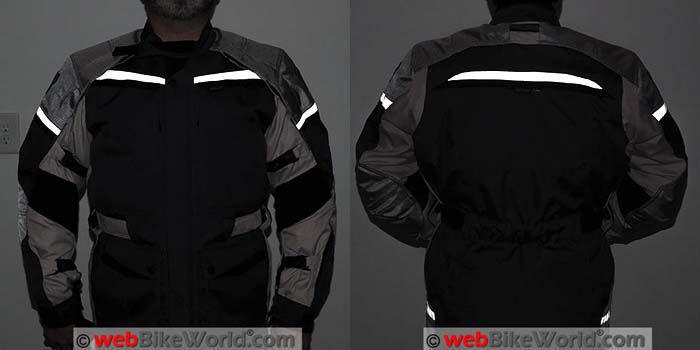
V2 Ventilation
Venting is a challenge on a jacket like the Trans Urban V2, as use of a permanent waterproof mid-liner is a barrier (literally) to airflow. The REISSA liner is breathable, but like most waterproof liners, it can only let so much air through. Large vents are provided in the sleeves that start near the neck and run down to mid-bicep.
The vent closures use waterproof zippers as well as hook-and-loop fasteners, the latter can be folded over in the flap to hold the vent open. The vent opening is backed with a flexible plastic-like mesh through which one can see the thin waterproof liner.
In the back between the shoulder blades is a large horizontal vent using the same waterproof zipper and hook-and-loop closure. The open flap doesn’t have the same “fold and hold open” flap like the sleeves but being an exhaust vent, it really isn’t necessary. The result of all of this is that with the vents open, the ventilation is acceptable. It recently became warm here in Nashville, just as I have been wrapping up this review.
Yesterday I rode him in 75 degree F (24 C) weather and I had the vents wide open. I could certainly feel the shoulder vents scooping in the air at speed and I could also feel a bit of cooling as the air moved from the the front of the jacket to the rear exhaust vent.
During some stop-and-go traffic on my way home it was getting warm enough in the bright sun that I was starting to sweat a bit, but once underway again the venting was still helpful, although slightly restricted. Is it as effective as a jacket with vents that allow air directly through to the rider? No. However, the system does provide a useful amount of cooling which does extend the seasonal range of the jacket a bit.
Once temperatures get into the 80 degree range (27 C) and above, I would switch to a lighter-weight jacket or eventually all mesh, but that’s pretty much the case with any 3/4-length adventure-touring jacket.
Pilot also makes not one but two mesh jackets for when the temperatures rise and we have one in house right now for a review. I’m just waiting for it to get warm enough to give it a try.
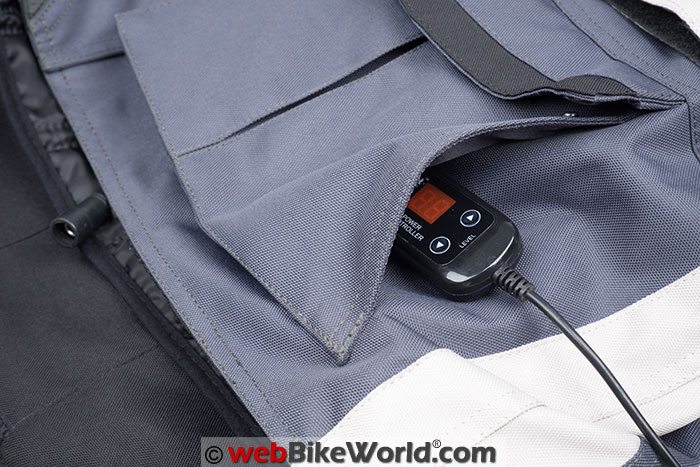
Pockets, Pockets and Pockets
You want pockets? The Trans Urban V2‘s got ‘em.
Chest Pockets
Starting up front there are two chest pockets with vertical access openings. These vertical zippered openings make it much easier to access the pocket contents than top loading pockets.
I’ve owned other jackets with top-loading chest pockets and it forces you to put your arm in an awkward position inside. Side-loading pockets are easy to access by using either hand.
Each chest pocket measures a huge 11 inches (28 cm) tall and is 8.6 inches (22 cm) at the widest point. The top upper third tapers a bit to 6 inches (15.25 cm) wide, making these chest pocket large enough for a variety of items.
A 1.5 inch (38 mm) gusset at the bottom of the chest pockets helps make space for thicker items to be stored. In the left side pocket there is a large plastic snap hook perfect onto which you can clip a key ring.
Cargo Pockets
Down lower on the front are two top-loading cargo pockets with fold over closures that fasten with hook-and-loop as well as a snap at each end of the closures. Each of these pockets measure 6.75 inches (17 cm) tall and 6.5 (16.5 cm) inches wide at the opening. These two pockets widen a bit to 7.75 inches (19.5 cm) at the bottom.
There are gussets along two sides as well as a “split” gusset at the front allowing the pocket to expand for thicker items. It would be nice to have waterproof zippers on these front pockets however, as the shell is apparently rather water resistant.
The fold-over closure will have to do and using one of the inner pockets that sits inside the REISSA membrane is probably the safest bet for waterproof storage.
Hand Warmer Pockets
Behind each of the lower pockets is an always open hand warmer pocket with a 5.25 inch (13.3 cm) opening. The left hand warmer pocket is where one will find the opening for the aforementioned heat controller pass through.
Interior Pockets
Moving to the interior of the jacket, we have several more pockets. In the right side there is a single pocket made from the same mesh of the interior lining measuring 7 inches (17.7 cm).
The left side includes a similar pocket of the same size and piggy-backed onto this pocket is a 4 inch (10 cm) by 7 inch (17.7 cm) cell phone pocket made from a solid nylon material. Hook-and-loop fastener is used to close these last three pockets.
Inside the left side behind the main closure is a red zipper that opens to a Napoleon style pocket. This pocket is larger than expected with a 6.5 inch (16.5 cm) opening and a 7.75 inch (19.7 cm) depth.
And Duplicate Pockets…
Pilot has thoughtfully duplicated the three lining-based pockets in the thermal liner so whether you are using the liner or not, the pockets are still all in the same place.
The zippered Napoleon pocket is still accessible with the liner installed.
Arm and Rear Pockets
You might think that‘s enough storage, but there’s more!
There is a pocket on the left forearm I mentioned earlier with a 5.25 inch (13.3 cm) zippered opening and it tapers from 2.5 inches (6.35 cm) to just 2 inch (5 cm). This ”At-Hand” pocket is too small for cell phones or wallets but is perfect for keys or ID cards and other similar sized items.
Finally, at the lower portion of the rear of the jacket is a large cargo pocket that opens at each side with a zipper. This one measures 12.5 inches (31.75 cm) wide and 10 inches (25.4 cm) tall with the zipper openings being a little smaller at just 7 inches (17.8 cm). Suffice to say that there is a lot of storage in this jacket! If you are someone who doesn’t care for luggage or has a bike that doesn’t provide much storage for it, you will be hard-pressed to find more storage space in similar gear.
Also: Motorcycle Jackets, Motorcycle Gloves, Motorcycle Boots, Motorcycle Pants
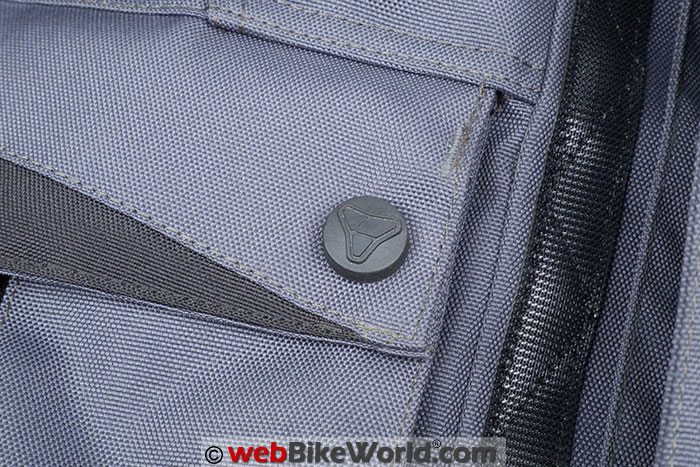
Removable Thermal Liner
Like the original Trans Urban jacket, a removable thermal liner is included with the V2. The liner uses Thermolite for insulation and it does a very good job, considering its light weight. During the winter, I used the V2 into the low 30’s (~0 C) with just the insulating liner and no additional electric heated gear on my commute of about 30-35 minutes, a combination of secondary and interstate highway roads.
Just the other day it was 33 degrees F (0.5 C) when I left for work (and yes, it was 75 degrees F a couple of days later!) and the only place I was feeling a chill was in my boots.
For full disclosure, I was wearing the Trans Urban V2 with the liner, the Pilot Dura overpants (review coming soon), my Dainese Fulcrum boots (review), and my Joe Rocket Nitrogen gloves (review). During the ride I had my Kawasaki Ninja 1000 (review) stock windscreen in the highest position, which helps but does not provide that much protection.
I could feel my chest getting a little cool after traveling on the highway for about ten minutes but then I was back on secondary roads. So for commuting duty, I didn’t need my electric vest at all. However, if I was planning on being out in near freezing temps for more than 30 minutes or so, I would suggest another layer and/or electrics.
Nevertheless, this is a good performance in cold weather for this jacket and the thermal liner is no doubt helped by the waterproof mid liner and shell keeping out the breeze.
Thermal Liner Attachment Notes
The thermal liner attaches with a zipper that runs all the way up and around the back on the inside of the jacket. In the sleeves there is a single connection using a short snap-together loop of fabric that connects to another loop.
Similar loops are also used along the lower back portion of the liner to attach it to the lower back portion of the shell.
All of these loops and connectors are bright red as part of the “RedTab” system used in the jacket. This makes them very easy to pick out against the black lining of the jacket.
Connection Zipper
Just a few inches up from the bottom of the liner is a slotted opening, used as a pass-through for the pants connection zipper. This is a necessity on most 3/4-length jackets as they extend pretty far down past the waist on pants. If you want the liner to extend with the shell then this pass-through is needed.
As I mentioned in the pocket section, there is duplicate the pocket layout of the main shell within the thermal liner. It’s a subtle feature but it is great to not have to try and remember the pocket configuration when the liner is installed or not; instead, the locations are always the same.
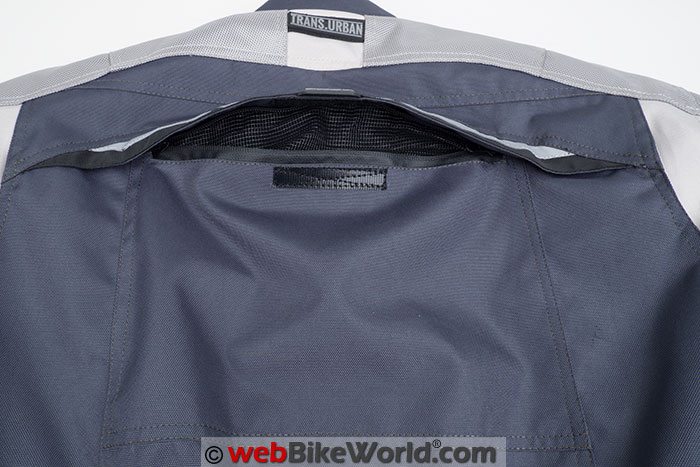
Collar
The collar on the Trans Urban Jacket V2 is essentially the same as on the original and this is good news. The design was a winner before, so why change? The collar is tall enough to offer good wind protection for the neck but it stays just shy of being in the way of a helmet strap, although of course this may be different for other riders that might like more or less collar.
But even if the height is a little too much for someone, the front section of the collar has a portion cut-out and in that space is a very soft and flexible material. This allows the collar to be snugly cinched without chafing the neck. The rest of the upper collar is also covered with a welt made from the same fabric providing a comfortable fit all the way around.
The collar attaches with a long strap to a hook-and-loop fastener and it provides a wide range of adjustment. On the left side by the shoulder vent is a short strap with a snap. This mates to a snap on the collar to allow it to be held open for a little additional air flow on those warmer days. You can also open one of two snaps at the top of the main closure to help get even more air down the front of the neck opening.
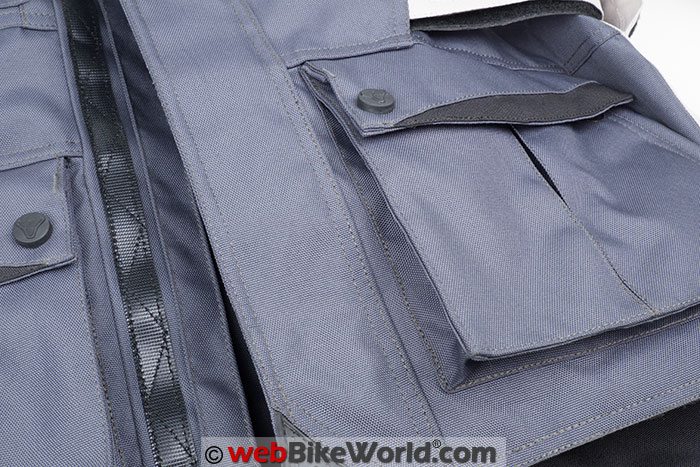
Zippers and Adjusters
YKK branded zippers are used throughout the Trans Urban V2. The main closure uses a very large coil dual zipper that operates very smoothly. The large size and smooth operation has a quality feel to it and it feels very secure. Smaller zippers are used on the sleeve vents and the front chest pockets.
To make them easy to grasp with gloves on, a nylon cord is attached to the pull with a contoured plastic tab. This is especially handy on the waterproof zippers on the sleeve vents as they take a stronger pull to open an close. The remaining zippers on the sleeve pocket, Napoleon pocket and rear pocket make do with just the standard metal pulls and seem fine for the task and space where they reside.
Adjusters are present for the sleeves at both the forearm and bicep positions, with three positions that can be snapped into place. The snaps, like the other snaps used in the jacket are rubber coated and are very secure once closed. The snap adjusters also have a large rubber tab surrounding them making them easy to grasp and change with gloves on.
A hook-and-loop strap at the sleeve cuffs can adjust the opening from over 10 inches (25.4 cm) down to a miniscule 5 inches (12.7 cm), all without having excess strap flopping in the wind. They will secure down that small!
At the waist (or a little above actually) are two adjustment straps that are connected to an elastic panel at the rear.
These straps allow for a very wide range of adjustment, much like the sleeve cuffs, with the elastic providing about 3 inches (7.6 cm) of stretch. The wide adjustment range is great and the elastic stretch provides a good balance of secure and comfortable fit.
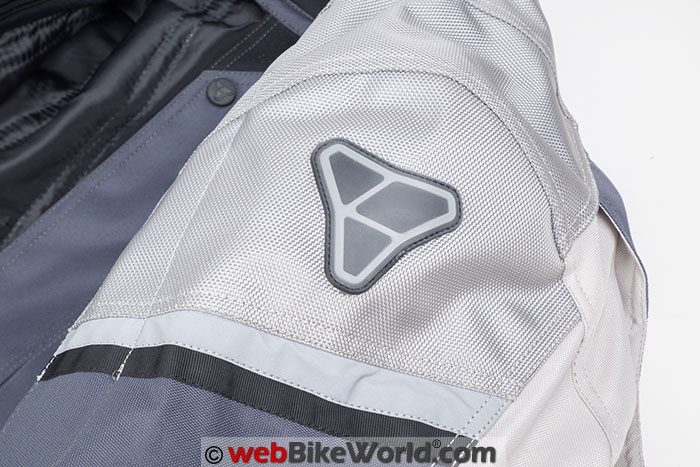
Sizing and Fit
The previous version of the Trans Urban jacket was about one size larger than expected but the new V2 runs close to the sizing on the Pilot size chart. I have a 42 inch chest (41.5 actually) and Pilot lists the size large as fitting a 42 to 44 chest. That means the V2 jacket feels like it is a little large for me, and that’s with the thermal liner installed. I am on the lower end of the sizing scale for the size large, so that’s not really unexpected. There are a couple of ways to look at this though. For a touring jacket like this, designed for cooler to warm weather, it’s good to have some extra space for adding additional layers when it is really cold or to have ample space for a heated vest or jacket.
So when trying on the size large, I thought that this was a good fit. However, I didn’t count on the thermal liner doing such a great job on its own. Having used it in the cold, I found I didn’t really need the additional layers. As such, I think the size medium would fit me better, especially since the adjustments on the size large allow for quite a bit of expansion. Even so, once adjusted down to fit me, the size large does a great job of behaving itself on the move, even at highway speeds where it never flaps in the wind.
The design of the shoulders — or more accurately the back of the shoulders — creates the appearance of some bulk, but this is due to a design feature. Where the sleeve meets the shoulder, there is extra material along back of the joint. This “fold” acts as an expansion panel to allow lots forward and across the body arm movement without restriction. It’s another small detail that, while making the area a bit bulkier, improves freedom of movement for the rider.
So what does all this boil down to?
I think if you’re between listed sizes, the size smaller would likely be the way to go, depending on whether you prefer a more snug fit or a looser fit.
Pilot certainly has the range of sizes covered though. The Trans Urban V2 is available in sizes ranging small all the way up to 4XL, which covers a range of chest sizes from 34 to 60 inches.
The good news is that if you order directly from Pilot, they offer one free exchange with the purchase of their ready-to-wear gear (custom suits not included, of course!).
One piece of bad news though is that there are currently not any women’s sizes available for the ready-to-wear products like the Trans Urban V2 jacket.
Protection
The protectors in the Trans Urban V2 have received an upgrade from the previous version of the jacket. The new pieces are of the rate-sensitive variety, meaning they are normally soft and pliable but become stiff when receiving an impact. This CE approved protection, referred to as “Core Force Active Armor” by Pilot, is in place in the shoulders and elbows within the jacket. It is removable, so it can be replaced and/or upgraded if desired.
The included back pad is just a simple foam piece which might offer some minimal impact protection but I’d highly recommend replacing it with a quality insert or even a stand-alone back protector.
Pilot offers their own CE certified back insert for only $40.00. The dimensions are pretty standard and it appears that the Forcefield Pro Level 2, size 001 (available here) back protector will fit. It’s a CE certified Level 2 back protector with Forcefield quality, so it may be the back protector you want to get for this jacket.
For my particular jacket I am using a Knox protector I already had on hand.
Chest Protection
Normally that would cover the discussion about protection as part of this review, but there’s one more piece to this puzzle. On the inside of right main closure panel is a large patch of hook-and-loop fastener, designed for use with the Pilot Core Chest protectors. Pilot has two sizes, the Full and Micro and both are compatible with the Trans Urban V2.
This is a great way to really step up the protective capability of this jacket.
Chest protectors are often overlooked by street riders (including me) but it is something I’m looking at buying now, since chest impacts are more common than back impacts for street riders during a crash.
Reflectivity
But internal protectors aren’t the only way to protect yourself when riding on the street. Visibility, especially at night, is very important to help prevent crashes in the first place.
For improved night-time visibility, the Trans Urban V2 maintains the same configuration of 3M Scotchlite material as the previous version. Two horizontal strips are in place above the chest pockets while another strips is present on each shoulder.
Around the back, there is one solid strip of reflective material across the upper back over the rear vent opening. The reflectivity coverage is good and the strips shine very brightly.
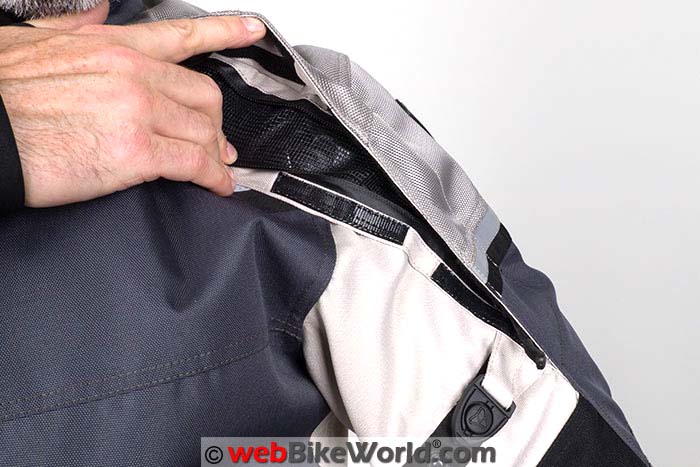
A Second Opinion
As it happens, I ended up with two Trans Urban V2 jackets. I have a friend who wears a size large and I knew that he needed to replace his aging Tourmaster Series 3 Transition jacket (review), so I gave him one of the Trans Urban V2’s. Kevin liked the jacket immediately upon seeing it. It fits into the same segment as the Transition jacket being 3/4 length, offering lots of storage, and venting for warmer weather and he also thought it looked pretty sharp too.
The fit is very good for him and he normally takes a large in most jacket brands. He finds it very comfortable and the overall quality he likens to the Transition jacket it’s replacing That’s good company as far as I’m concerned as that is also a very good touring jacket for the money from a major manufacturer (Tourmaster). As luck would have it, just days after receiving the jacket, Kevin had the opportunity to find out how well the Trans Urban V2 does in a heavy rain.
I’m pleased to report he remained completely dry and found no water leaked past waterproof lining. He didn’t find much (if any) evidence that any water even made it past the outer shell.
The fact the sizing and fit is similar to the Transition jacket for him confirms for me the feeling that these jackets run a little generous on sizing. Tourmaster gear has always fit a little larger on me than most brands.
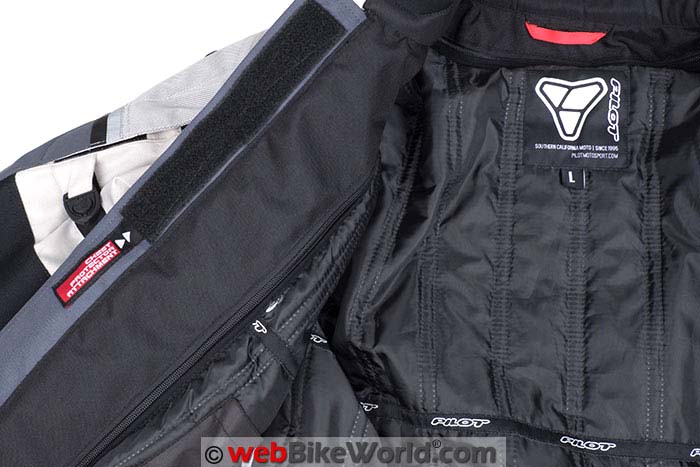
Conclusion
Like the first version of the Trans Urban jacket, the new Trans Urban V2 offers a great deal of performance for the price. The incremental updates such as the styling changes and the new protectors are welcome and these updates thankfully didn’t come at the cost of removing anything that we enjoyed about the original. They also come at a very modest increase of price at just $15.00, less than 7 percent over the past three and half years.
Sizing seems more accurate than the first version of the jacket and the Trans Urban offers a wide range of adjustment to accommodate most any differences in sizes. The Trans Urban V2 is a great choice for a do-it-all motorcycle riding jacket.
It has lots of storage, excellent waterproofing and lots of attention to detail all in a well put together package.
The jacket also combines well with the Pilot Dura overpants (review coming soon) to create a very good three-season riding suit. Factor in the price ($240.00 USD) and the included two year warranty and it’s hard to go wrong with this versatile and good-looking jacket.
Part 2: Pilot Dura Over Pants Review
More webBikeWorld:
Owner Comments and Feedback
From “B.P.” (April 2017): “I’m in agreement with “J.D.” (below) regarding clammy permanent liners and their lack of ventilation. My position hasn’t changed since penning “The All-Season Motorcycle Riding Outfit“. That is, for cold and wet riding, from the inside out: shirt; electric liner (on or not); water- and wind-proof golf shirt or equivalent; armored mesh jacket; pants and overpants. For cold riding: same as cold and wet. For cool riding: store either the electric liner or the golf shirt.
For warm and wet riding: store the electric liner. For hot riding: store both the electric liner and golf shirt, and possibly store the riding pants (depending on your desired protection level, whether you wear something like the Bohn system, and so forth) or switch to shorts and overpants. J.D. may want to re-visit that three-year-old article and its comments, as it seems he’s more in that camp.”
From “J.D.” (April 2017): “I like the jacket up to the point of having a waterproof membrane permanently installed. My experience with any garment with such a feature is negative. I ride year round in the southeastern US and the afflicted garments do not breath well. Winter has my under layers cold and clammy. A pair of jeans are damp after 1/2 hour. Moisture wicking fabrics seem to help but are mostly too cool for winter. Once Spring arrives, excessive heat and lack of air flow take over. Designers should leave out the membrane. How often DO we ride in rain and for how long? I have found a good application of KIWI Camp Dry keeps me dry for all except the toad strangler deluge. A rain suit keeps the underlayer pocket contents dry as well.”


